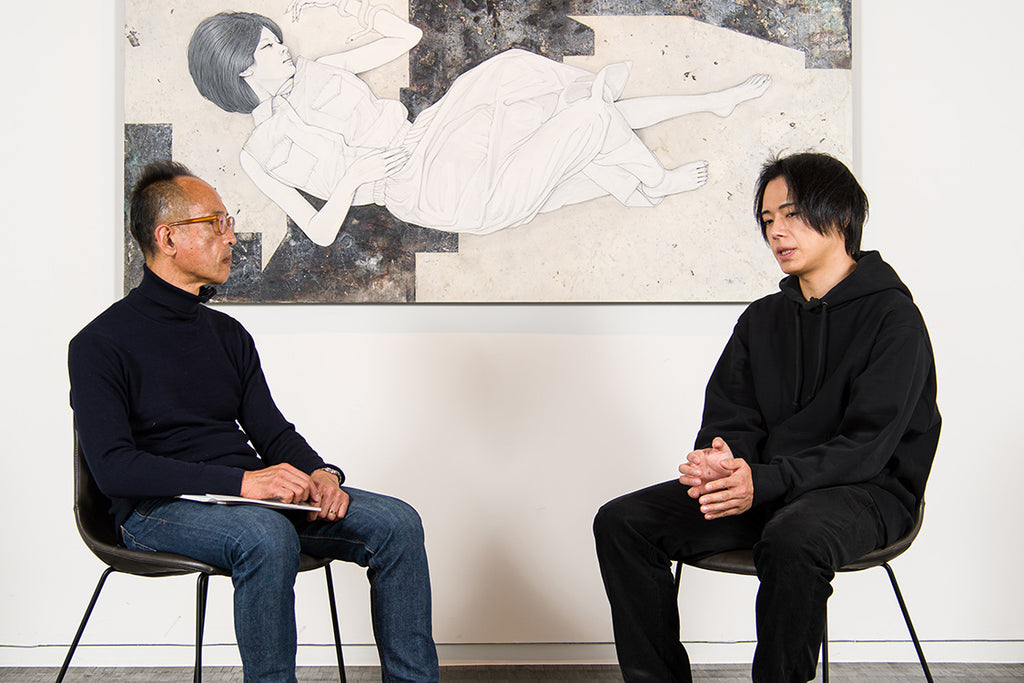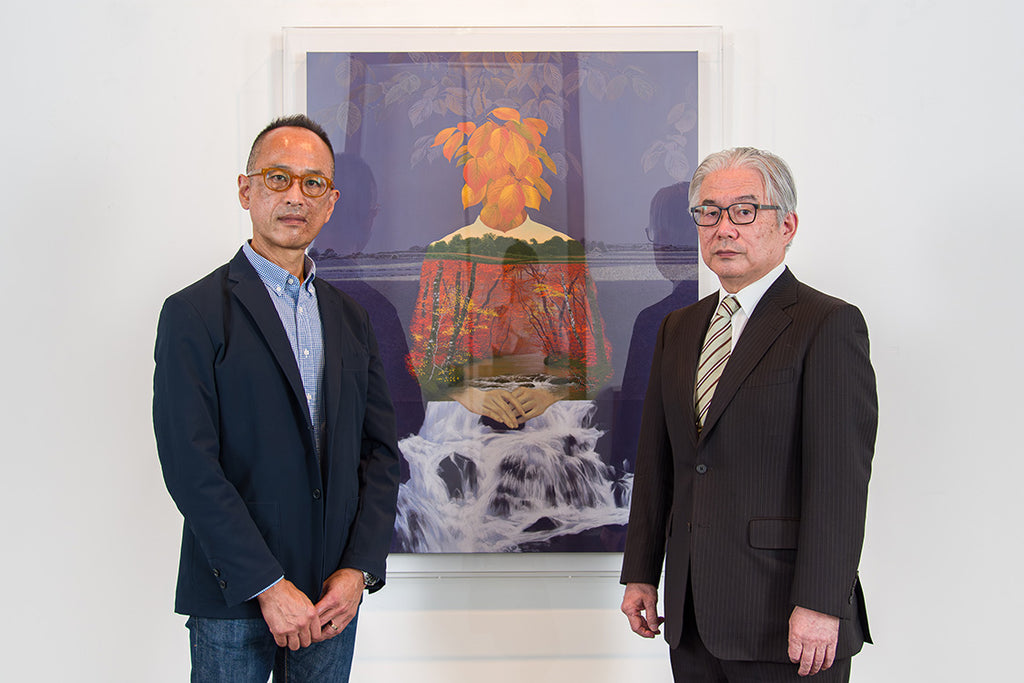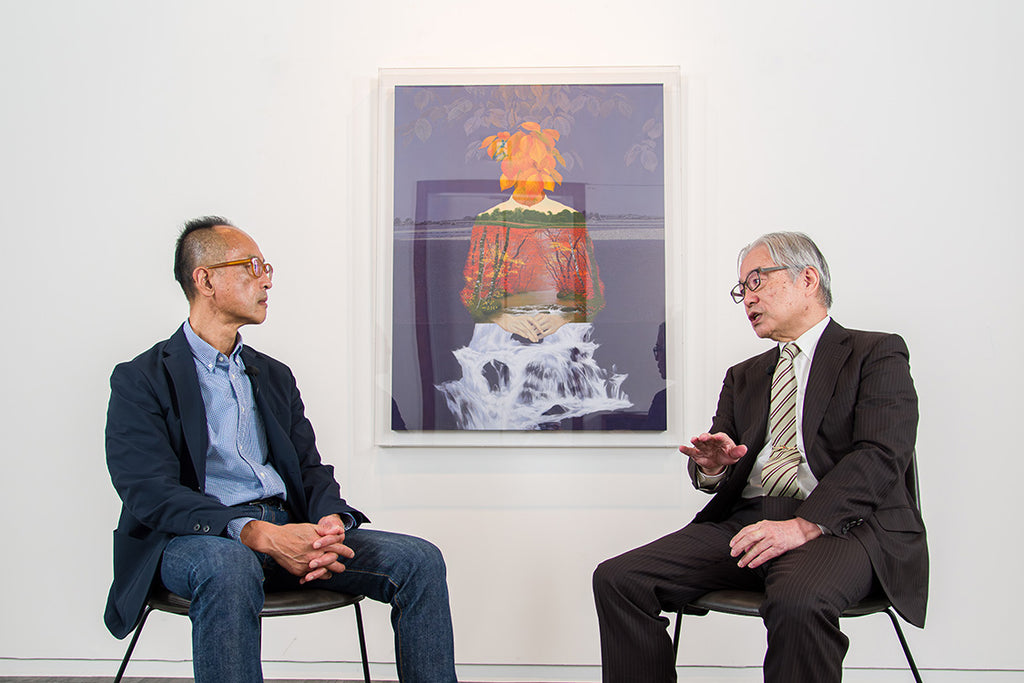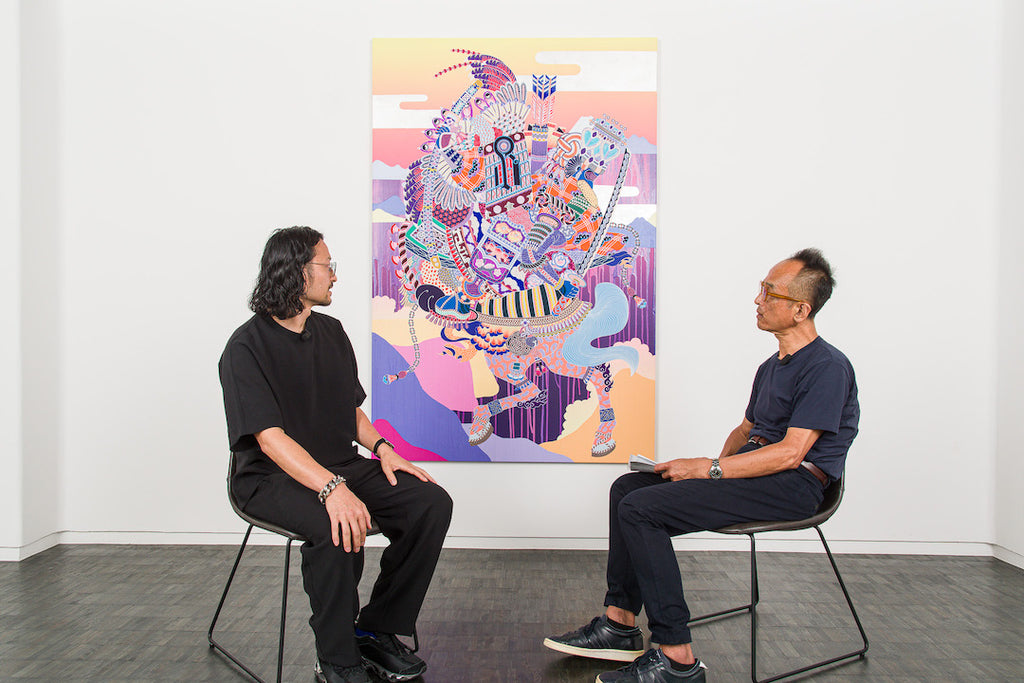ARTICLES
Yu Kawashima × Meiji Hijikata | A World of Ink Beyond the Bounds of Nihonga
2024.2.1
INTERVIEW

Meiji Hijikata × Yu Kawashima
This series of articles features conversations between various artists and Meiji Hijikata, Director of the Taro Okamoto Museum of Art, Kawasaki, to take a deeper look into their artworks. The fourth installment is a dialogue with Yu Kawashima, an artist who seamlessly traverses the contrasting realms of Nihonga (traditional Japanese painting) and contemporary art.
Their conversation begins with a discussion of Kawashima's Grand Prix award-winning submission for the FACE 2014, a public entry competition hosted by the Sompo Japan Nipponkoa Museum of Art.
"Yu Kawashima: PATHOS" exhibition at the Whitestone Gallery Seoul
Winning the Grand Prix at the FACE Exhibition, a Gateway to Success in Contemporary Art
Hijikata: Though I have seen your works several times before, this is actually my first time to talk to you. I first became aware of your art when you won the Grand Prix at the FACE exhibition.
Kawashima: That was exactly ten years ago in 2013. I was still 25 years old.
Hijikata: The FACE exhibition was still a new exhibition at that time, but it was already garnering attention in the field of contemporary art. I think your submission was very well-made. What is the meaning behind its title, "TOXIC"?
Kawashima: "TOXIC" can mean "poisonous" or "harmful", but at the time, I was feeling weighed down by anxiety and a sense of turbulence around me, and I often wondered how I was supposed to continue living in this world. I even thought of the possibility that this act of selfishly expressing my emotions was something harmful to the world. From the combination of all these things, the first impression I got was the word "TOXIC", so I decided to use it as the title.
Beautiful Artwork Reinforced by Realism and a Sense of Substance

Yu Kawashima 《EROSION》 2023, 72.7 × 50.0 cm, Silver leaf, mineral pigments, ink on hemp paper
Hijikata: It has long been said that realism is the current trend in art. Your paintings have a realistic feel, yet they also have a good touch of Nihonga. Can you tell me the specific techniques you use?
Kawashima: I mount washi (Japanese paper) on a wooden panel, then I draw the painting using black sumi ink and mineral pigments, which is the traditional method used in Nihonga. In my case, I make my own paints, with a special technique for my black color. I use copper powder to graphitize sumi ink then make it into a fine powder, before dissolving it in nikawa solution.
Hijikata: What kind of effect do you aim for with that technique?
Kawashima: First and foremost, to enhance its sense of substance as a material. I want to augment the material texture of my black colors. I also do it to blur the outlines in my paintings. Normally, sumi ink enhances the edges when drawn on paper. But adding copper makes the ink dry in a convex shape on the paper surface, causing the outlines to be blurred. This allows me to draw the contours and the parts extending into the foreground without giving the impression that they were attached.
In order to alter the texture and appearance of my paintings in this way, I went through a lot of trial and error before finally deciding on the kind of ink that is most suitable for my current style.
A Respect for the Traditions of Nihonga and His Forerunners

Oxidation of silver leaf. By stopping the process at different stages, various colors such as a deep greenish blue or a rust red can be obtained.
Hijikata: You said that you had to do a lot of trial and error for your pigments. What made you decide to do Nihonga in the first place?
Kawashima: When I was a child, I stumbled across art books kept by my grandfather and among them, Nihonga captured my attention. The very first I saw was a collection by Hashimoto Gaho (1835 - 1908), and it was unforgettable. The patterns and textures appeared majestic, almost divine. That experience remains etched in my memory.
Hijikata: How old were you when you saw Hashimoto Gaho's art collection?
Kawashima: I think I was around 4 or 5 years old at the time.
Hijikata: It must have been a formative experience for you.
Kawashima: It certainly was. I vividly recall the colors I encountered back then ー a rich sepia ink-like color with a subtle purple hue, imbued with a textural finish. I believe that some of the images I saw at the time still influence my art today.
Hijikata: In a sense, Gaho’s art was rooted in traditional Japanese painting, but it also had a modern feel. He was also a master of line art.
From a Childhood Pastime to a Lifelong Passion
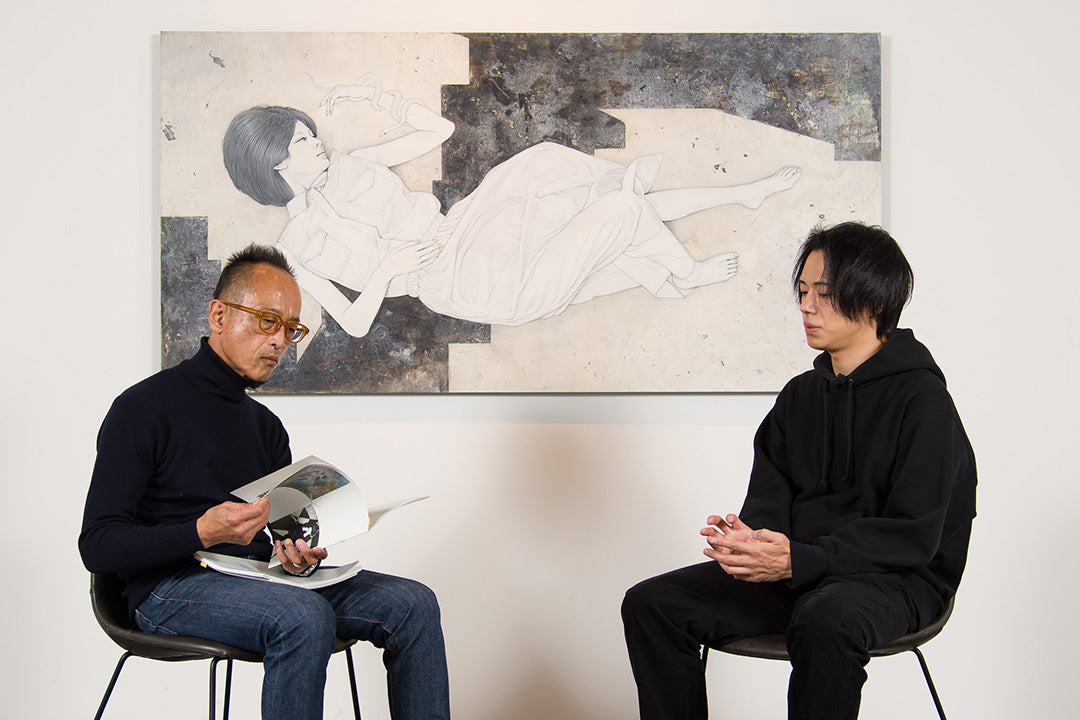
Meiji Hijikata × Yu Kawashima
During his junior high school years, Kawashima devoted himself to kendo, and considered art as just a pastime. But his desire to eventually pursue a career that requires the skillful use of his hands made him decide to take the path of art, and he was able to enter an art high school without any preparatory lessons. In high school, he was amazed at the talent of his peers, but it did not diminish his enjoyment of painting. The strong sense of exhilaration he felt for Nihonga since his childhood also led him to choose Nihonga as his specialization in university.
Hijikata: After getting admitted to the Aichi University of the Arts, you began to study Nihonga in earnest. What kind of things did you study during this time?
Kawashima: Actually I took a two-year gap before I entered the university. When I was in high school, I wanted to study at the Tokyo University of the Arts, so I attended various preparatory schools. I had a lot of time to study for the entrance examination and was able to practice plaster cast drawing more than anyone else.
One of the strengths of my university is cultural property conservation and restoration. I had many opportunities to work with cultural artifacts, and I was able to dive deep in historical art materials and techniques. I also wanted to thoroughly learn traditional painting techniques, and I honed my skills during my 4-year undergraduate course.
Hijikata: It seems like you went through a very stoic training period, not to mention your two gap years. I myself teach at an art university, and I think that students who can sketch and draw lines like you are few and far between. You have an expressive ability that can truly persuade your viewers. Can you tell me about your art instructor?
Kawashima: I was able to develop my current style of painting thanks to my instructor, Koji Matsumura. When I began my undergraduate studies, the university's culture was starting to change, and the first thing that Professor Matsumura told me was to do as I pleased. He provided guidance with regards to techniques, but in terms of philosophy and aesthetics, he more or less left it to my discretion. This gave me plenty of time to work on my art by myself.
A Return to Ink after a Foray into Mineral Pigments

Yu Kawashima 《Ghost》 2023, 65.2 × 65.2 cm, Silver leaf, mineral pigments, ink on hemp paper
Hijikata: When did you start making artworks that mainly used sumi ink?
Kawashima: I started during my graduation project in my final undergraduate year at university. Up to that point, I had always painted using mineral pigments.
Hijikata: Did you use a thick painting style?
Kawashima: Yes, I used a thick style more often than a thin one. For my preliminary graduation project, I wanted to give my all into a painting that made full use of the mineral pigment techniques I knew. I created a painting of a group of four men, which actually became my first prize-winning work for the Inten exhibition.
Hijikata: You were already making submissions to the Inten back then?
Kawashima: Yes. Originally, you could only make a submission to Inten if you were at least in graduate school, but applications were opened up to everyone when I was in my fourth undergraduate year. I took that opportunity to challenge myself, so I submitted my painting and it won me my first award. I was happy with the award, but to be honest, that painting turned out quite differently from what I had envisioned, and I strongly felt that it was a complete failure.
Hijikata: Why did you feel that way?
Kawashima: I probably had a strong preconceived notion that I have to express my artworks using mineral pigments. Through trial and error, I only became able to make my own judgments about mineral pigments when I was in my fourth year at university, and I probably had too much expectation for what I could achieve just by finishing that painting. But after looking at the completed work, I made the decision to stop using this material to express my art. From there, I completely changed the materials for my graduation project, creating a self-portrait using mainly sumi ink.
Hijikata: Based on what you said, it seems that you gave everything you had for your first prize-winning work at the Inten, but looking back, you were probably putting too much pressure on yourself. I think you can say that that experience made you realize the kind of expression you truly wanted to pursue, and it gave birth to your monochrome world.
A Monochrome World that is Rich in Color

Kawashima’s “Charmer” (2023) took several months to create. It started from a sketch then went through the Nihonga process of “oshitazu” (full-size draft), before work began on the actual painting.
Hijikata: Since your graduation work, have you been making only monochrome paintings using sumi ink?
Kawashima: My paintings are often described as being monochrome, but I actually feel colors in them, and I make slight changes to the ink and other materials with every work.
Hijikata: I think your works have the feel of the black and white world of Georges Rouault (1871-1958) and Odilon Redon (1840-1916). There is also the Japanese saying that goes “Sumi ni gosai ari“(sumi has a multitude of colors), which conveys the infinite nuances of black ink. Has there been a change in your approach to mineral pigments and your creative process?
Kawashima: My current techniques are actually completely different from those I used for my graduation work.
Hijikata: In what way?
Kawashima: My penchant for drawing people has remained the same, but when using sumi ink, I initially could not express them completely in a painting, and I often had to make depictions that relied on observation.
For example, in my graduation work, I used motifs that are concrete and symbolic, such as vines, a concrete wall, and a mandala. It was an attempt to maintain its coherence as a painting despite the collision of various meanings. But in my current works, I rarely use such concrete motifs that are highly symbolic. This is because using any kind of motif, or even just a specific human pose, can inevitably give it some deeper meaning.
Hijikata: Indeed, the same can be said for facial expressions.
Kawashima: That is why I try to depict my paintings in a more morphological manner. In my mind, they bear a deep significance, but rather than simply conveying those meanings, I aim to present them to others in an entirely new form that arises from their own emotions.
"Yu Kawashima: PATHOS" exhibition at the Whitestone Gallery Seoul
Since winning the Grand Prix at the FACE exhibition at the age of 25, Yu Kawashima has continued a process of trial and error in order to take his work into a higher dimension. Despite making changes to his approach to painting, his themes and motifs have remained consistent. In the second part of the article, Kawashima talks about the anxiety and the images of young girls that constitute the core of his works.


